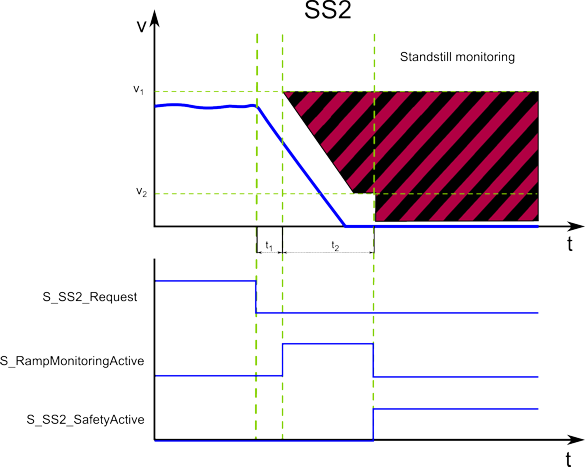General function description
The Safe Stop 2 function causes a rapid and controlled stopping of a motor. It controls the drive to decelerate autonomously and finally monitors standstill (similar to the SOS function). As a result, the motor is still supplied with power, thus being able to resist external forces and the position control remains active to perform a standstill monitoring.
(In contrast, the Safe Stop 1 function finally activates the STO function instead of the SS2 standstill monitoring.)
SS2 can realize a safety-related stop in accordance with stop category 2 according to EN 60204-1.
Monitoring by the safety-related FB/Safety Module
The monitoring behavior by the function block depends on the parameterization of the Safety Module:
If ramp monitoring is deactivated, monitoring is passive until the t2 time interval has elapsed (see figure and description below).
If ramp monitoring is activated, the Safety Module monitors the motor deceleration rate specified by the deceleration ramp.
In both cases, the SS2 function stops the motor and then performs the SS2 standstill monitoring.
The request of the safety-related function occurs at the beginning of the t1 time interval ('S_SS2_Request' signal in the diagram). t1 is set with the device parameter SS2_StartDelayTime[t1].

Within the t1 time interval, the standard (non-safety-related) controller also receives the request from the connected process and initiates the motion control function according to the logic and drive parameterization defined in the standard (non-safety-related) application.
After t1 has elapsed, the deceleration of the drive is executed. The maximum allowed duration t2 of this ramp-down phase is defined by the device parameter SS2_RampMonitoringTime[t2].
At the end of t2, speed must be zero and standstill monitoring (similar to the SOS function) is activated.
During t2, the deceleration can be monitored by setting the device parameter SS2_RampMonitoring = Activated.
If ramp monitoring is deactivated, the deceleration curve is not monitored. Even acceleration is allowed during the t2 interval. Standstill has to be achieved the latest before t2 elapses. Otherwise, STO is activated as the defined fallback function.
If ramp monitoring is activated, the deceleration curve is monitored and must follow the parameterized ramp (as shown in the figure). Otherwise, STO is activated as the defined fallback function.
After zero speed has been achieved and while t2 has not yet elapsed, a velocity tolerance of the axis is allowed and monitored relative to v2.
If the SS2 monitored standstill is successfully achieved, the function block switches S_SS2_SafetyActive = SAFETRUE (see diagram).
Otherwise, if the STO fallback function has been activated due to an error detected as described above, this is indicated by S_STO_SafetyActive = SAFETRUE.
Fallback function
If the parameterized SS2_RampMonitoringTime[t2] value is exceeded, or (in case of activated ramp monitoring) if the parameterized deceleration ramp is not respected as defined, or if the position tolerance (sTol) is exceeded, the STO function is automatically executed as the fallback function.
Application
The SS2 function is used if a controlled deceleration of the drive with a following standstill monitoring is required, e.g., during commissioning or after a safety-relevant event.
SS2 is suitable to bring a large flywheel mass as quickly as possible to a halt or to slow down and come to a standstill from high drive speeds as fast as possible. Typical examples are grinding spindles, centrifuges, storage and retrieval devices.
How to implement the safety function
To implement this safety function in your safety-related application proceed as follows:
In EcoStruxure Machine Expert 'Devices' window, insert a safety module for the drive used.
In EcoStruxure Machine Expert - Safety, insert a Preventa Motion FB SF_SafeMotionControl into the safety-related code and connect it accordingly.
In the EcoStruxure Machine Expert - Safety 'Devices' window, mark the safety module in the devices tree and edit the safety-related parameters in the 'Mechanic' group and in the 'SafeStop2' group.
For details, refer to the parameter description of the Lexium 62 LXM Safety Option Module/Lexium 62 ILM Safety Option Module.